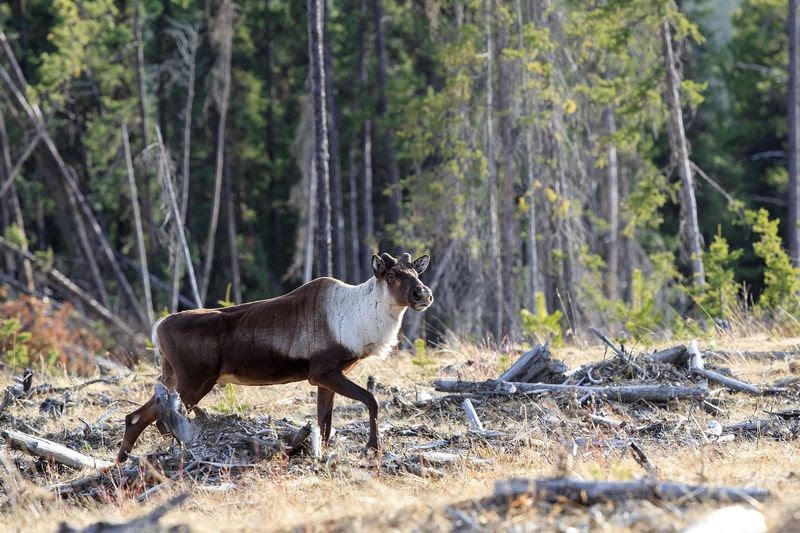Conservation groups are warning that a proposed Alberta government plan for a sub-region in west-central Alberta would wipe out two caribou populations if implemented.
The draft plan for the Upper Smoky sub-region would enable the U.S.-based timber company Weyerhaeuser to entirely clearcut the last winter range forests. The plan would also increase oil and gas developments in these caribou ranges.
“This sub-regional plan was supposed to protect and support the recovery of Alberta’s last remaining southern mountain caribou populations,” said Pamela Narváez-Torres, conservation specialist with the Alberta Wilderness Association, in a statement. “Instead, the government has introduced a draft plan that does the opposite – enabling even more industrial development in caribou critical habitat. This level of habitat loss will push these caribou populations to extinction.”
Located in west-central Alberta, the Upper Smoky covers more than 13,000 square kilometres south of Grande Prairie and encompasses Grande Cache, Kakwa Wildland Park and about half of Willmore Wilderness Park.
On March 27, the Alberta government opened consultations on its draft Upper Smoky Sub-Regional Plan. Public engagement runs until June 25 and can be completed online.
“The Upper Smoky is a diverse and breathtaking part of our province. It’s also the heart of many of our key industries and Alberta’s economy,” said Rebecca Schulz, minister of Environment and Protected Areas, in a news release. “We want to hear from anyone living in the area who is passionate about creating jobs, growing rural communities and supporting sustainable conservation in the area, so we can create the best plans possible to meet these demands.”
The Upper Smoky contains timber, petroleum and natural gas, coal, minerals and other natural resources. The Alberta government estimates that $21.2 billion of Alberta’s GDP was derived from this sub-region in 2020, around six per cent of the province’s GDP.
The sub-region is also home to the Narraway and Redrock-Prairie Creek woodland caribou populations and ranges, two of the last three populations remaining on provincially managed land.
Caribou herds along the Eastern Slopes have declined in recent decades, but the Alberta government says significant progress has been made toward restoring caribou habitat. Over 2,600 kilometres of seismic lines have been treated and assessed since 2020, and 1.8 million trees have been planted.
In response to the Upper Smoky draft plan, however, a joint statement was issued by conservation groups, including the Alberta Wilderness Association, Pembina Institute, the Wildlife Society and the David Suzuki Foundation.
According to these groups, the draft plan allows Weyerhaeuser to clearcut the remaining critical winter habitat and eliminate the ability of these caribou to annually migrate to the foothill’s forests.
“They stay in their summer ranges, and there’s not enough resources for them in the winter to survive, but then they face other challenges like avalanches that could kill the whole herd,” Narváez-Torres said in an interview.
Weyerhaeuser did not immediately respond to a request for comment.
A Caribou Task Force, made up of Indigenous groups, industry, municipalities, various user groups and interest groups, had been established to advise the Alberta government on Upper Smoky sub-regional planning. These multi-stakeholder conversations were held from 2019 to 2021.
Narváez-Torres noted that none of the task force’s recommendations related to caribou conservation and recovery were reflected in the report. The plan also does not list caribou conservation or recovery as objectives.
The draft plan also proposes establishing conservation areas in mountainous areas adjacent to Willmore Wilderness Park and Kakwa Wildland Park. While Narváez-Torres applauded the proposal, she indicated how this wouldn’t be sufficient for caribou recovery.
“It is outside winter range, and so we still think it’s great, but it doesn’t really protect what the carriers need,” she said. “Any oil and gas or anything that has been approved before the draft plan will continue, so although the areas will be protected, somehow, there’s still going to be industry development happening in the area.”
Ryan Fournier, press secretary to Schulz, emphasized in an email that the plan was not final, and the content in the draft materials was “designed to help generate input and detailed feedback from those most impacted.”
“We are working to strike the right balance to protect our environment while keeping people working,” Fournier said. “Once engagement is complete, we will review what we heard and will use it to inform our finalized plan.”
Narváez-Torres stated they would be encouraging the public and other organizations to provide feedback to the Alberta government about the need to protect mountain caribou.
“We’re still trying to put together our strategy on how we’re going to proceed, but we’re definitely going to push, and we’re definitely hoping that the fact that this is a draft plan that it’s not going to be the final word, because we really don’t want it the way it is,” she said.




